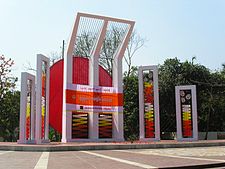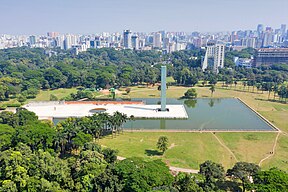
Back Dhaka ACE Dhaka AF Dhaka ALS ዳካ AM Dhaka AN دكا Arabic داكا (مدينة) ARY داكا ARZ ঢাকা AS Dhaka AST
Dhaka is the capital and largest city of Bangladesh. Dhaka is a megacity, and has a population of 10.2 million residents as of 2022, and a population of over 22.4 million residents in Greater Dhaka.[15][16][17] It is widely considered to be one of the most densely populated built-up urban area in the world.
It is located just north of the Buriganga River, a channel of the Dhaleswari River, in the south-central part of the country. Dhaka is Bangladesh’s most populous city and is one of the largest metropolises in South Asia. Pop. (2001) city, 5,333,571; metro. area, 9,672,763; (2011) city, 7,033,075; metro. area, 14,543,124.
It was part of the Mughal Empire of Hindustan and served as the capital of the empire twice. Once from 1608 to 1639 and once from 1660 to 1704. After that, it became a part of the British Raj. Then it became a part of Pakistan as part of the Partition of India on 15 August 1947. Bangladesh was then called East Pakistan, and Dacca (Dhaka) became provincial capital of East Pakistan. In 1971, the new nation of Bangladesh was created.
Dhaka is home to Bangladesh Bank which is the country's central bank. Many multinational companies have offices in the city. The Dhaka Stock Exchange is one of the largest stock exchanges in South Asia.
The Bangabhaban in Dhaka is the official residence and workplace of the President of Bangladesh. It is also home to the National Parliament House.
There are 52 universities in Dhaka. Dhaka College was started in 1841, making it the oldest institution for higher education in the city.

- ↑ Imam, Shah Husain (20 July 2018). "Dhaka: Where will it go from here?". The Daily Star (Opinion). Retrieved 2 March 2022.
Dhaka, once the Venice of the East by virtue of being surrounded by four ebullient rivers, is now an urban behemoth.
- ↑ "The tales of urban street children:Is there anything we could do?". Dhaka Tribune. 10 December 2019.
- ↑ "Are we willing to know more of Dhaka?". The Daily Star. 4 May 2018.
- ↑ 4.0 4.1 "Hasan Mahmud states 3 reasons behind low voter turnout". The Daily Star. UNB. 2 February 2020. Archived from the original on 2 February 2020. Retrieved 2 February 2020.
- ↑ 5.0 5.1 "Dhaka Metropolitan City Area". Archived from the original on 29 September 2017. Retrieved 29 September 2017.
- ↑ Partha Pratim Bhattacharjee; Mahbubur Rahman Khan (7 May 2016). "Govt to double size of Dhaka city area". The Daily Star. Archived from the original on 2 March 2017. Retrieved 1 March 2017.
- ↑ "Dhaka City expands by more than double after inclusion of 16 union councils". bdnews24.com. 9 May 2016. Archived from the original on 2 March 2017. Retrieved 1 March 2017.
- ↑ "Dhaka, Bangladesh Map". National Geographic. Archived from the original on 7 January 2010. Retrieved 6 September 2009.
- ↑ "Dhaka (Bangladesh): City Districts and Subdistricts - Population Statistics, Charts and Map". www.citypopulation.de. Retrieved 19 January 2022.
- ↑ "Population & Housing Census-2011" (PDF). Bangladesh Bureau of Statistics. p. 41. Archived from the original (PDF) on 8 December 2015. Retrieved 15 December 2015.
- ↑ "Sub-national HDI - Area Database - Global Data Lab". hdi.globaldatalab.org. Retrieved 2023-02-08.
- ↑ "TelluBase: Dhaka Extract" (PDF). tellusant.com. Retrieved 1 June 2023.
- ↑ "Evolving Urban Form: Dhaka | Newgeography.com". www.newgeography.com. Retrieved 19 January 2022.
- ↑ "District Statistics 2011, Dhaka" (PDF). Bangladesh Bureau of Statistics. December 2013. Archived from the original (PDF) on 24 April 2015. Retrieved 14 May 2015.
- ↑ "Dhaka ranks world's sixth most populous city". Dhaka Tribune. 2022-01-14. Archived from the original on 2023-01-15. Retrieved 2023-01-15.
- ↑ "Population & Housing Census-2011" (PDF). Bangladesh Bureau of Statistics. Archived from the original (PDF) on 8 December 2015. Retrieved 17 May 2021.
- ↑ "The World's Most Densely Populated Cities". WorldAtlas. 4 October 2020.





